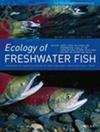Small Streams Support Beta Diversity in Neotropical Fish Assemblages in the Upper Paraná River Basin
Abstract
Variation in species composition along an environmental gradient (β-diversity) can inform our understanding of biodiversity patterns and species composition. Beta diversity can be partitioned into species contributions to beta diversity (SCBD) and local contributions to beta diversity (LCBD). While SCBD describes the variations in species composition among samples, LCBD measures the uniqueness of a biological community within a larger ecosystem. Recently developed metrics enabled the estimation of species contribution to total beta diversity (SCBD) and the contribution of individual sites to total beta diversity (LCBD). Utilising these metrics, a one-time survey of 275 sampling points within four sub-basins of the Upper Paraná River Hydrographic Basin (low-flow streams, < 5 m3/s) was conducted to assess fish community composition. Our results show that limnological influences at different scales contribute to higher LCBD. However, land use and species richness were not directly linked to this outcome, suggesting that sites with fewer fish species along sub-basins contributed to higher beta diversity. It was concluded that beta diversity is more influenced by limnological characteristics and the position of sampling sites along the longitudinal gradient than that based on variations in species composition (SCBD). Moreover, high LCBD values were even found in portions of the gradient with lower species richness. This means that small streams in the sub-basins of the upper Paraná River are unique and are comprised of varied habitats that contribute to increasing diversity. As such, they should be seen as a target in the development of environmental policies designed to conserve their pristine condition.

 求助内容:
求助内容: 应助结果提醒方式:
应助结果提醒方式:


